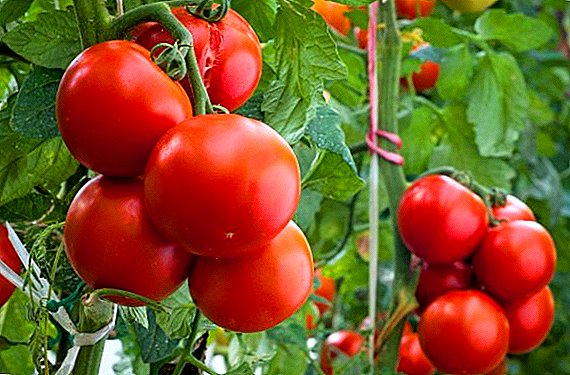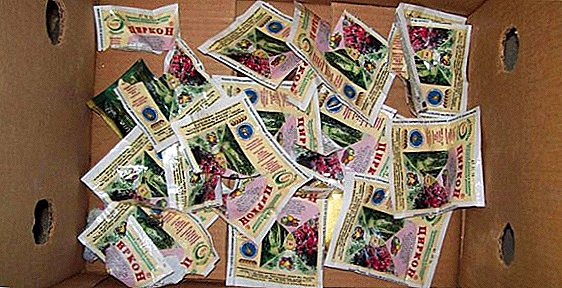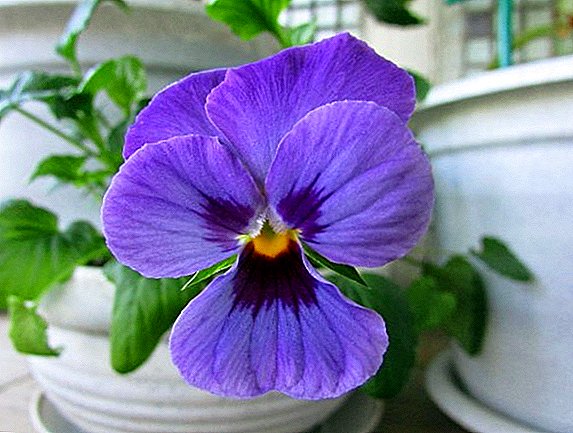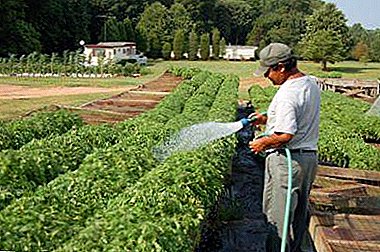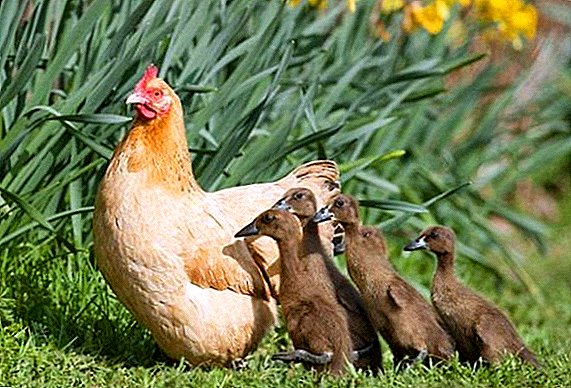 Breeding poultry brings a good income, which can be significantly increased by growing several species of birds, such as chickens and ducks. In the conditions of a small territory of the household economy, the question arises about the lack of space for individual poultry houses. In this article we will consider the possibility of sharing the contents of different families.
Breeding poultry brings a good income, which can be significantly increased by growing several species of birds, such as chickens and ducks. In the conditions of a small territory of the household economy, the question arises about the lack of space for individual poultry houses. In this article we will consider the possibility of sharing the contents of different families.
Difficulties you may encounter when keeping birds together
The main problem of sharing is the love of waterfowl for moisture, while for chicken stock, excessive moisture is fraught with disease. Ducks have a habit of drinking their food in their beak. 
Naturally, part of the feed emitted from the beak falls into the bowl of the drinker, except that the birds splash water on the litter. The chicken squad, in turn, loves to scrape the grain from the feeder, in the end it all remains on the litter.
In connection with this problem number two appears: frequent cleaning. To avoid constant humidity, it is better to equip individual drinkers and feed pets at different times.
Did you know? In ancient Greece, the rooster was associated with Persephone, the goddess of fertility and the wife of Hades, the lord of the realm of the dead. According to the myth, the goddess spent half the year in the kingdom of her spouse, half a year on Olympus, and the herald was her herald in returning to the world of the living.
In a bird's hostel, a spirit of rivalry may also arise, aggression will lead to loss of appetite, stress and a drop in productivity as a result. 
Features of the joint content in the house
There are many differences between chickens and ducks, but there are similarities in habitat conditions and needs, let's look in more detail.
Learn more about whether chickens and ducks can be kept in the same room.
Common positions of chickens and ducks
So, what is common:
- Both species need a warm room, without drafts;
- Both families should be protected from rodents and wild birds, as well as from possible pests and peddlers of diseases;
- cleaning and regular disinfection must be carried out in poultry houses;
- ducks and chickens need to extend daylight in the winter;
- individuals need a well thought out and balanced diet, fresh water, vaccination against diseases;
- before the age of one month there are no differences in the care of the chicks.

Opposing positions
When arranging the house should be noted that the ducks are adapted for life on the litter. Chickens prefer to rest at a height, clasping the perch of a perch with a height of about 50-70 cm. In this case, it is necessary to correctly calculate the population density per square meter: chickens - up to 5 individuals, ducks - no more than 3.
It will be useful for you to learn how to build a house correctly, how to build a chicken coop, how to equip a chicken coop for the winter, how to choose and use a fermentation bedding in the chicken coop.
There is a difference in the preferences of the hens: the ducks prefer twilight when incubating the masonry, the hens need lighting. In addition, the chicken will quietly take someone else's egg for his own and sit out the lining, the duck is likely to throw the clutch.
Ducks definitely need to provide a reservoir on the run, chickens do not like water, moreover, humidity is destructive for them. Even in winter, ducks need to clean their feathers somewhere, they need a water tank. The chicken family also needs baths, but with ashes.
Ducks are fed up to 4-5 times a day, chicken stock - no more than 3 times, the amount of food per day also varies. Drinking bowls need to be placed separately: for chickens - at the height of the eye level (nipple), the drinking bowl is placed on the floor. 
Advantages and disadvantages of co-location
Perhaps the only advantage of such a tandem is the saving of space in a small backyard area. To some extent, the maintenance of cleanliness in the house is simplified: it is easier to clean one room than to perform the same procedures twice.
The disadvantages are relatively more:
- waterfowl can create an increased atmosphere of humidity that will lead to diseases of chickens;
- cleaning will have to be done more often, especially with regard to bedding and washing bird dishes;
- you need to think carefully about the organization of feeding - separate drinkers and feeders;
- take into account the preferences of conditions for rest and laying eggs;
- constantly monitor the possible manifestations of aggression;
- think over the lighting system, separate for different families.

Poorly organized arrangement for any kind of bird can affect productivity: because of stress, egg production can decline, the appetite will disappear, and with it - broiler weight gain.
Did you know? According to the Guinness Book of Records, the oldest duck that survived its 25th anniversary is considered to be a drake from the UK called Will-Kwak-Kwak.
Feeding features
Chickens. The daily dose of feed in the chicken diet is approximately 130-135 grams, This includes:
- grain (wheat, barley, corn) - 70 g;
- bone meal - 2 g;
- salt - 0.5 g;
- greens and vegetables - 30 g;
- bran - 20 g;
- additives (minerals, vitamins) - 10 g.
Find out what should be the diet of chickens, how to feed laying hens, how to feed chickens correctly in winter.
In the warm season, enough greenery on the run, vegetables can be added to the wet food. The feeding regime is usually divided into three times: in the morning and in the evening - dry food, at lunch - mash. 
Ducks. Adults should receive an average of 380 grams of feed per day. The diet includes:
- grain - 200 g;
- greens - 100 g;
- bran - 80 g;
- vitamins and minerals - 3-5 g.
In the warm season, the amount of green consumption increases: ducks on the condition of a living pond collect duckweed. During this period, it is not necessary to add fish oil to the feed.
Learn what and how to feed ducks in winter and summer.
The diet for both species of birds is calculated more accurately depending on the direction of the breed (meat or egg), as well as the season. 
Features of rearing chicks
Up to one month of age there are no fundamental differences in the care of chicks.
Important! Breeds for both birds are prepared immediately before eating, as wet foods quickly turn sour.
Conditions for keeping chickens and ducklings:
- temperature. Until the week of age - 30 ° C, the second week - 26 ° C, then gradually reduced to 18 ° C;
- lighting. The first days of daylight hours - 20 hours, gradually reduced to 12 hours;
- bedding. Be sure to dry up to a month of life, depends on the health of chicks, ducklings, including;
- fresh water available. Both chickens and ducklings need it around the clock in a large volume.
The diet and diet for kids is the same:
- first day of life - boiled egg;
- up to three days - low-fat cottage cheese, porridge;
- up to ten days - crushed steamed grain, mash, chopped greens, fish oil and other vitamins;
- twice a week, the chicks are watered with a weak pink solution of potassium permanganate.

To feed the babies at the same time, so as not to create stressful conditions. You should not put the drinkers near the feeders, the ducklings quickly pollute the water, trying to immediately drink the food. If the drinker is far away, the chick will have time to swallow the food and the drinker will remain clean.
Ducklings on a reservoir with adults are released at three weeks of age, and subject to incubation and warmth outside, at a week-old age.
Rules of keeping different birds
Choice of breed. To avoid conflicts, a properly chosen breed of one and another species will help, the more calm and peaceful nature birds have, the easier it is for them to get along.
The room. The best option is to divide into two zones. To equip one section based on the needs of chickens, the other - taking into account the interests of waterfowl. Perches for chickens are located at a height of 50-70 cm from the floor, ducks - floor content with deep bedding. 
Nutrition. First of all, they feed larger and more voracious, that is, ducks. To avoid dirt and moisture will help the placement of drinkers in the distance from the feeders. Scattering the feed will alert the mesh fence, with large cells so that the bird can only stick its head (10 cm).
Important! The joint content of chickens and ducklings from the first days of life significantly reduces the risk of conflict between adults.
Lighting. When breeding hens of both families, you should consider a separate lighting for chicken nests, which does not interfere with the ducks, who prefer twilight. It should be noted that the hens are more aggressive in nature than meat breeds, so the nests should be located at a distance from each other. 
Walking. If the territory for walking is small, it is better to divide it into two sections: with a pond for ducks, with a trough filled with ash and an obligatory shed for rain and heat for chickens.
To summarize: examining the needs and habits of each of the poultry families, it is possible to ensure smooth coexistence of species in the same area. Thus, it is possible to increase the income from the household and rationally use a small area of the site.
Feedback from network users




